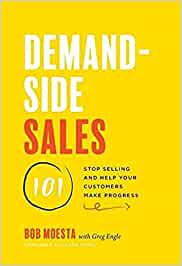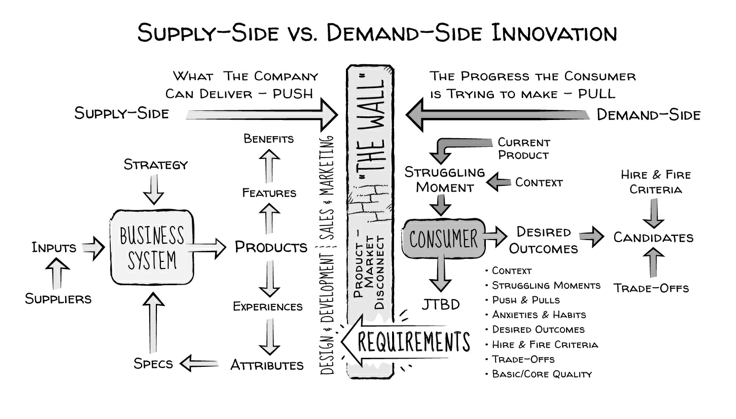Demand-Side Sales
Demand-side selling is understanding what progress people want to make, and what they are willing to pay to make that progress. Our product or services are merely part of their solution.

Nobody wants to be sold to, but everybody wants to buy.
Most people don’t think about your product or service if it doesn’t address a problem they have.
When something’s not working the struggling moment occurs. It forces people to stop and ask themselves a question. It’s those questions that spur demand. When you study how people buy, you realize if there’s no struggle, there’s no demand—without demand people don’t buy.

Supply-side Sales
- What the company can deliver - Push - Selling
- The focus is on the product or service and its features and benefits.
- How will I sell my product?
Demand-side Sales
- What the customers want - Pull - Buying
- The focus is on understanding the buyer and the user
- How do people buy and how do they make progress?
You create pull for your product because you are focused on helping the customer. Great salespeople help customers make progress in their lives, on their terms. They don’t sell; they help. They listen, understand what you want to achieve, and help you achieve it. A better title would be “concierge”.
Reduce obstructions. How many people want to make a change but can’t figure out the details? If we could help solve their roadblocks and move them through the phases of buying, we were much more likely to sell.
We didn’t create more things, we took care of their anxieties, which increased the pushes.
The Buyer’s Journey

When making a purchase, the buyer goes through following six stages:
First Thought
- Creates the space in the brain
- Once you have the first thought, you’ve opened up the space in your mind for the information.
- Without this first thought there is no demand. But once you have it, you notice things you didn’t notice before, which causes you to transition to passive looking.
- How to create first thought? Ask good questions, tell a story, give new metrics, state the obvious. You want the buyer to question what they are doing and realize it’s not working.
Passive Looking
- The first thought is how you create the space. Passive looking is how you start to fill the space. It’s realizing you need to do something about the problem.
- You have a hole, a nagging feeling, you are struggling, but you don’t know enough to move forward.
- It’s about learning. The moment they start planning, they enter in the next step.
Active Looking
- Active looking is asking yourself: “What are the alternatives for making progress?”
- Start seeing the possibilities. Make plans, spend time to make progress and move forward.
- This is where people start to invest time, effort, and thought to see the solution.
- Now buyers also need a second event, a domino, before they can move to the next step on the timeline. If there’s no timeline, they might look forever.
Deciding
- The outcome of active looking is that the buyer knows what they want. This is where people make their trade-offs and ultimately decide what they want.
- There’s no ideal solution when buying and every customer makes trade-offs. Understand the trade-offs your customers are willing to make.
- Provide reference points. Without comparisons, people struggle to buy. They need to reject something before they can buy something else.
- A “time wall” or a “deadline” forces them to choose, rather than endlessly look.
Onboarding (big hire)
- This is where the buyer determines if you, your product, or your service meets their expectations.
- They use your offering and measure their experience against their expectations.
- Here’s where it’s important that the metrics set in deciding are the right metrics; otherwise the consumer will be dissatisfied and have buyer’s remorse.
- You want the customer to not only feel satisfied but excited and delighted about aspects they didn’t know they’d wanted to get.
Onboarding Use (little hire)
- When you design a product, you need to build it to be bought and used.
- In ongoing use, the consumer decides if a product or service is doing the job through a series of repeated little hires each time they use the product or service.
- The satisfaction is determined by the expectations we set in earlier.
- If you did not set expectations well, the consumer will have new struggling moments, which over time can lead to a new big hire. Ongoing use is where the jobs get done and the progress is achieved.
Sales, Marketing, and Customer Support should play together well with the buyer’s journey. Don’t think of them as separate entities. First thought, passive looking, and active looking are a combination of marketing and sales. Deciding, onboarding and ongoing use are a combination of customer support and sales.
Systemizing the Six Phases
Think of each of the six phases in the sales process as a system, like a “black box” problem in math, with inputs, outputs, and outcomes.
Meet the buyer in each of the six stages - first thought, passive looking, active looking, deciding, and ownership—with an input.
Your goal is to create an input for each of the six stages of buying, that triggers a desired output, which ultimately leads to the next stage.
Find the Struggling Moment
Demand-side selling starts with the struggling moment. It’s the theory that people buy when they have a struggling moment and think, “Maybe, I can do better.”
Find the struggling moments and understand how to solve them. People don’t think about hiring and firing a product or service until they have a struggling moment. What are your customer’s struggling moments? They’re not what you think they are.
Think progress! What’s the progress your customer is trying to make? Now, enable them to do THAT. It’s the progress that matters, not your features and benefits.
Identify the Trade-offs
Don’t talk features, benefits, and cost, because people are willing to make tradeoffs. What makes your product or service kick ass? Where do you say no? Basically, choose what to suck at.
Understand that unfulfilled “little hires” cause “big hires”. What does that mean? The struggling moment starts in the “little hires” and if someone struggles too much they’ll accumulate to a “big hire.” Focus on the “little hires”.